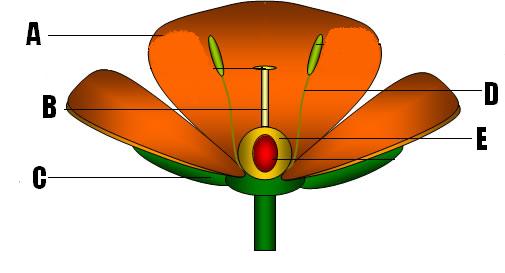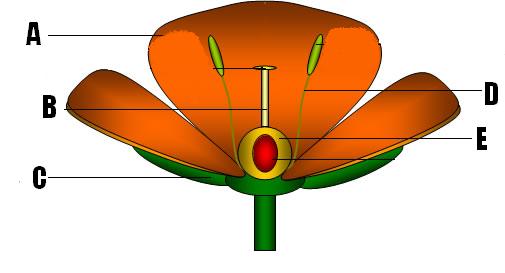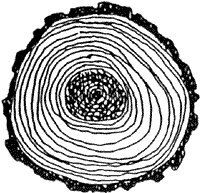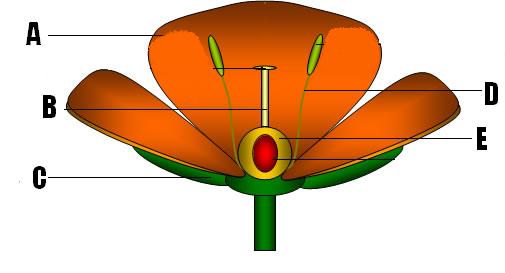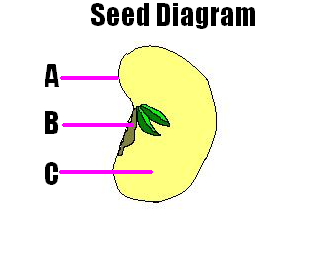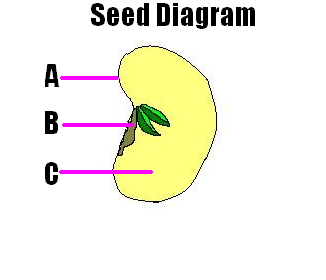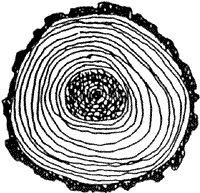The Structure And Function Of Plants! Trivia Facts Quiz
(22).jpg)
.
- 1.
The structure that transports water up the stem:
- A.
Sloem
- B.
Phloem
- C.
Tuber
- D.
Xylem
- E.
Elevator
Correct Answer
D. XylemExplanation
Xylem is the correct answer because it is the structure in plants that is responsible for transporting water from the roots to the rest of the plant. It consists of specialized cells that form a network of tubes, allowing water to move upwards against gravity. This process is known as transpiration, and it plays a crucial role in providing water and nutrients to all parts of the plant. The other options listed, such as sloem, phloem, tuber, and elevator, are not involved in water transportation in plants.Rate this question:
-
- 2.
Water is transported to the leaves where it is combined with ____________ to form sugar.
- A.
Oxygen
- B.
Carbon dioxide
- C.
Glucose
- D.
Carbon monoxide
Correct Answer
B. Carbon dioxideExplanation
Water is transported to the leaves through the xylem vessels. In the leaves, carbon dioxide from the atmosphere enters the leaf through tiny openings called stomata. Inside the leaf, carbon dioxide combines with water in the presence of sunlight and chlorophyll during the process of photosynthesis. This chemical reaction converts carbon dioxide and water into glucose, a type of sugar. Therefore, the correct answer is carbon dioxide.Rate this question:
-
- 3.
This structure is responsible for creating new tubes(xylem and phloem) in the stem.
- A.
Vascular cambium
- B.
Pith
- C.
Heartwood
- D.
Sapwood
- E.
Tube creator guy
Correct Answer
A. Vascular cambiumExplanation
The correct answer is vascular cambium. The vascular cambium is a layer of cells in the stem that is responsible for producing new xylem and phloem tissues. It is a meristematic tissue that undergoes cell division, resulting in the formation of secondary growth in the stem. This secondary growth leads to the thickening of the stem and the formation of new tubes, such as xylem for water transport and phloem for nutrient transport. The vascular cambium plays a crucial role in the growth and development of the stem.Rate this question:
-
- 4.
Which of the following is an example of a root?
- A.
Carrot
- B.
Beet
- C.
Radish
- D.
A, b, and c
Correct Answer
D. A, b, and cExplanation
The correct answer is a, b, and c. All three options (carrot, beet, and radish) are examples of roots because they are the edible underground parts of plants that typically absorb water and nutrients from the soil.Rate this question:
-
- 5.
Roots have a cap at the tip. What is it used for?
- A.
Root growth
- B.
Cell division
- C.
Food storage
- D.
Protection of the root
Correct Answer
D. Protection of the rootExplanation
The cap at the tip of roots is used for protection. It acts as a shield, preventing damage to the delicate growing tip of the root as it pushes through the soil. The cap helps to navigate the root through the soil particles, protecting it from abrasion and mechanical injury. Additionally, the cap secretes lubricating substances that aid in the root's movement through the soil. Overall, the cap plays a crucial role in safeguarding the root during its growth and development.Rate this question:
-
- 6.
Phloem is used to transport
- A.
Water up
- B.
Water down
- C.
Glucose down
- D.
Animals up
- E.
Very dangerous nuclear waste material from the CIA
Correct Answer
C. Glucose downExplanation
Phloem is a specialized tissue in plants that is responsible for transporting organic nutrients, including glucose, from the leaves to other parts of the plant, such as the roots, stems, and fruits. This process is known as translocation, and it allows the plant to distribute the sugars produced during photosynthesis to areas where they are needed for growth, energy storage, or storage as starch. Therefore, the correct answer is "glucose down" as phloem transports glucose from the leaves downwards to other plant parts.Rate this question:
-
- 7.
What is the structure labeled A?
- A.
Sepal
- B.
Petal
- C.
Anther
- D.
Filament
Correct Answer
B. PetalExplanation
The structure labeled A is a petal. Petals are the colorful, leaf-like structures of a flower that are often used to attract pollinators. They are typically located inside the sepals and surround the reproductive organs of the flower. Petals come in a variety of shapes, sizes, and colors, and their main function is to attract insects or other animals for pollination.Rate this question:
-
- 8.
What structure is labeled D?
- A.
Sepal
- B.
Petal
- C.
Anther
- D.
Filament
Correct Answer
D. FilamentExplanation
The structure labeled D is the filament. The filament is a long, thin stalk that supports the anther in a flower. It is responsible for holding the anther in the optimal position for pollen dispersal.Rate this question:
-
- 9.
Why do flowers have such colorful petals?
- A.
So you can see them at night.
- B.
To trap insects.
- C.
To scare away predators.
- D.
To attract animals for pollination.
- E.
Petals don't have color.
Correct Answer
D. To attract animals for pollination.Explanation
Flowers have colorful petals to attract animals for pollination. The bright colors and patterns of the petals act as visual signals that help attract pollinators such as bees, butterflies, and birds. These animals are attracted to the flowers because they associate the colors with a potential source of nectar or pollen. As the animals visit the flowers to feed, they inadvertently transfer pollen from one flower to another, aiding in the process of pollination and ensuring the reproduction of the plant.Rate this question:
-
- 10.
Which of the following is NOT a way seeds are dispersed(dispersed means spread around)?
- A.
Sun
- B.
Wind
- C.
Water
- D.
Animals
Correct Answer
A. SunExplanation
Seeds are dispersed through various methods, such as wind, water, and animals. However, the sun is not a way seeds are dispersed. The sun plays a crucial role in the germination process of seeds by providing the necessary light and heat for growth, but it does not actively spread seeds around like the other options mentioned.Rate this question:
-
- 11.
Which of the following are NOT ingredients for photosynthesis?
- A.
Carbon dioxide
- B.
Oxygen
- C.
Water
- D.
Sunlight
Correct Answer
B. OxygenExplanation
Oxygen is not an ingredient for photosynthesis. Photosynthesis is the process by which plants convert carbon dioxide, water, and sunlight into glucose and oxygen. Oxygen is actually a byproduct of photosynthesis, released into the atmosphere. Therefore, it is not considered an ingredient for the process itself.Rate this question:
-
- 12.
What are the products of photosynthesis?
- A.
Carbon dioxide and water
- B.
Oxygen and glucose(sugar)
- C.
Oxygen and carbon dioxide
- D.
Just carbon dioxide
Correct Answer
B. Oxygen and glucose(sugar)Explanation
Photosynthesis is the process by which plants convert sunlight, carbon dioxide, and water into glucose (sugar) and oxygen. Oxygen is released as a byproduct, which is essential for the survival of many organisms. Glucose, on the other hand, is used by the plant as an energy source for growth and other metabolic activities. Therefore, the correct answer is oxygen and glucose (sugar).Rate this question:
-
- 13.
Every plant can do this, fundamental process, and we can call this ____________.
- A.
Respiration
- B.
Photosynthesis
- C.
Growing
Correct Answer
B. PhotosynthesisExplanation
Photosynthesis is the correct answer because it is the fundamental process that every plant can perform. It is the process by which plants convert sunlight, carbon dioxide, and water into glucose (a form of sugar) and oxygen. This process is essential for plants to produce their own food and release oxygen into the atmosphere. Respiration is the process by which organisms convert glucose and oxygen into energy, and while it is also important for plants, it is not the specific process described in the question. Growing is a general term that does not specifically refer to the process mentioned.Rate this question:
-
- 14.
What are these tree rings made up of?
- A.
Xylem
- B.
Phloem
- C.
Pith
- D.
Bark
- E.
Candy
Correct Answer
A. XylemExplanation
Tree rings are made up of xylem. Xylem is a type of tissue in plants that transports water and nutrients from the roots to the rest of the plant. It is responsible for providing support and structure to the plant. Tree rings are formed by the annual growth of xylem cells, with each ring representing one year of growth. The width of the rings can provide information about the age of the tree and the environmental conditions it experienced during each year of growth.Rate this question:
-
- 15.
What structure is labeled with letter E?
- A.
Pistil
- B.
Stamen
- C.
Sepal
- D.
Ovary
- E.
Stem
Correct Answer
D. OvaryExplanation
The structure labeled with letter E is the ovary. The ovary is a part of the female reproductive system in plants and it contains the ovules, which develop into seeds after fertilization. It is located at the base of the pistil, which is the female reproductive organ in a flower. The ovary plays a crucial role in the process of pollination and fertilization, as it protects and nourishes the developing seeds.Rate this question:
-
- 16.
What part of the bean seed is stored food?
- A.
A
- B.
B
- C.
C
Correct Answer
C. CExplanation
The stored food in a bean seed is primarily located in the cotyledons, which are the thick, fleshy structures inside the seed. These cotyledons provide nourishment for the developing embryo until it can establish its own photosynthesis process. Therefore, option C is the correct answer.Rate this question:
-
- 17.
What structure is labeled with B?
- A.
Cotyledon
- B.
Seed coat
- C.
Embryo
- D.
Stem
- E.
Flower
Correct Answer
C. EmbryoExplanation
The structure labeled with B is the embryo. The embryo is the early stage of development of a plant or animal, in this case, a plant. It is the structure that will eventually grow into a new plant. The other options, such as cotyledon, seed coat, stem, and flower, are different parts of a plant but are not specifically labeled with B in this question.Rate this question:
-
- 18.
What plant part produces pollen?
- A.
Stigma
- B.
Anther
- C.
Style
- D.
Ovary
- E.
Cotyledon
Correct Answer
B. AntherExplanation
The anther is the plant part that produces pollen. It is located at the top of the stamen, which is the male reproductive organ of a flower. The anther contains pollen sacs, which release pollen grains. These pollen grains are then transferred to the stigma of the flower, where they can fertilize the ovules and lead to the production of seeds.Rate this question:
-
- 19.
Where does carbon dioxide enter a plant?
- A.
Stoma
- B.
Root
- C.
Stem
- D.
Flower
Correct Answer
A. StomaExplanation
Carbon dioxide enters a plant through the stomata. Stomata are small openings on the surface of leaves and stems that allow for gas exchange. They are surrounded by guard cells that can open and close the stomata to regulate the entry and exit of gases. When the stomata are open, carbon dioxide from the atmosphere diffuses into the plant, where it is used in photosynthesis to produce glucose and oxygen.Rate this question:
-
- 20.
Where in the plant does photosynthesis occur?
- A.
Stem
- B.
Leaves
- C.
Roots
- D.
Xylem
Correct Answer
B. LeavesExplanation
Photosynthesis occurs in the leaves of a plant. This process involves the conversion of sunlight, water, and carbon dioxide into glucose and oxygen using chlorophyll present in the chloroplasts of the leaf cells. The leaves have a large surface area and are positioned to receive maximum sunlight, which is essential for photosynthesis to take place. Additionally, the leaves have specialized structures called stomata that allow the exchange of gases necessary for photosynthesis. Therefore, the correct answer is leaves.Rate this question:
-
- 21.
If is was a wet year the tree rings would be wide. This is because the tree produced more_____________.
- A.
Roots
- B.
Phloem
- C.
Xylem
- D.
Bark
- E.
Leaves
Correct Answer
C. XylemExplanation
In a wet year, the tree has access to more water, which leads to increased growth and production of xylem. Xylem is responsible for transporting water and nutrients from the roots to the rest of the tree. Therefore, the wider tree rings indicate that the tree produced more xylem in response to the abundance of water.Rate this question:
-
- 22.
Why is the cotyledon a necessary part of the seed?
- A.
The embryo needs food.
- B.
It softens the seed coat.
- C.
It is necessary for photosynthesis.
- D.
It is not a necessary part of the seed.
Correct Answer
A. The embryo needs food.Explanation
The cotyledon is a necessary part of the seed because it serves as a food source for the developing embryo. During germination, the cotyledon provides nutrients and energy to support the growth of the embryo until it can establish its own photosynthetic capabilities. Without the cotyledon, the embryo would not have enough resources to survive and grow into a mature plant.Rate this question:
-
- 23.
The early growth of an embryo plant, or the breaking through of the seed coat is called____________
- A.
Photosynthesis
- B.
Attraction
- C.
Diffusion
- D.
Germination
- E.
Respiration
Correct Answer
D. GerminationExplanation
Germination refers to the early growth of an embryo plant or the breaking through of the seed coat. During germination, the seed absorbs water, which triggers metabolic processes leading to the emergence of a new plant. This process involves the activation of enzymes, respiration, and the conversion of stored nutrients into energy for growth. Photosynthesis, attraction, diffusion, and respiration are not specific to the early growth of an embryo plant, making germination the correct answer.Rate this question:
-
- 24.
What part of the stem is the darker part in the middle?
- A.
Cambium
- B.
Bark
- C.
Phloem
- D.
Pith
Correct Answer
D. PithExplanation
The darker part in the middle of the stem is called the pith. The pith is a soft, spongy tissue found in the center of the stem. It is responsible for storing and transporting nutrients and water throughout the plant. The pith is usually darker in color compared to other parts of the stem, which is why it is the correct answer to the question.Rate this question:
-
- 25.
Where does the energy come from to make sugar during photosynthesis?
- A.
Sunlight
- B.
Respiration
- C.
Minerals from the ground
- D.
Wind
- E.
Water
Correct Answer
A. SunlightExplanation
During photosynthesis, plants use sunlight as the primary source of energy to convert carbon dioxide and water into glucose (sugar). This process occurs in the chloroplasts of plant cells, specifically in the chlorophyll pigments. Sunlight is absorbed by chlorophyll, which initiates a series of chemical reactions that ultimately produce glucose. Therefore, sunlight is the fundamental source of energy that fuels the synthesis of sugar during photosynthesis.Rate this question:
-
Quiz Review Timeline +
Our quizzes are rigorously reviewed, monitored and continuously updated by our expert board to maintain accuracy, relevance, and timeliness.
-
Current Version
-
Mar 21, 2023Quiz Edited by
ProProfs Editorial Team -
Nov 20, 2008Quiz Created by
Mhaldorson
- Air Quizzes
- Atmosphere Quizzes
- Beach Quizzes
- Biome Quizzes
- Climate Quizzes
- Conservation Quizzes
- Desert Quizzes
- Diffusion Quizzes
- Disaster Quizzes
- Ecosystem Quizzes
- Evolution Quizzes
- Fire Quizzes
- Forest Quizzes
- Global Warming Quizzes
- Lake Quizzes
- Landform Quizzes
- Mountain Quizzes
- Natural Resource Quizzes
- Nature Of Matter Quizzes
- Osmosis Quizzes
- Pollution Quizzes
- Recycling Quizzes
- River Quizzes
- Sea Quizzes
- Season Quizzes
- Soil Quizzes
- Water Quizzes
- Weather Quizzes
- Wildlife Quizzes
- Wind Quizzes



